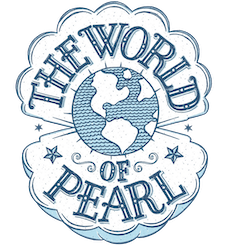“Three pearls in eighteen months? Three pearls in eighteen months!” I questioned, then exclaimed. In eighteen months, our pearl diver discovered exactly three pearls. I did not mean it as a point of criticism, I meant it as a marvel of natural pearls. Frizz had been diving in the Tennessee River for a year and a half, gathering mussel shells. And in that year and a half, he had discovered exactly three pearls. Small purple pearls that came from the same mussel. The implications are significant: natural pearls are rare wonders of nature.
The backstory? There remains a small export business of pearl shells that originate from Tennessee River. Many years ago international pearl dealers discovered the beauty in U.S. mussel shells. They are thick, heavy shells and many are a pure white color. They are perfect for nucleating saltwater cultured pearls. Remember, saltwater pearls are cultured by inserting a bead and epithelial cells in the oyster and it forms the pearl as a coating on top of the nucleus. Here is a nucleus being inserted into a saltwater Black-Lipped Oyster:
And here is the cross section of the Tahitian pearl after it has been nucleated and the pearl has formed on top of the nucleus:
This is a great example of what the inside of a pearl looks like especially since the nacre (the pearl making material) is dark so it provides a nice contrast to the white nucleus.
So, a bit of history. After the international cultured pearl farms discovered the marvelous shells from the Tennessee River, a huge export business was born. This business provided jobs for thousands of pearl divers and many shell businesses grew on the banks of the Tennessee River. These days, business is not so good. These international cultured pearl farms are using other materials for the nucleus of their pearls including their own native shells so the demand is way down. Most freshwater pearls do not even use a shell for a nucleus. This has changed things for the Tennessee River pearl divers.
But, there are still some men working on the river. Last year the number of permits was less than one hundred. One of the men still diving is Frizz:
Frizz is one of the last remaining divers on the Tennessee River and he comes from a family of divers. His father owned a shell company and he and his brother was born on the river. Diving is in his blood. He has returned to diving after many years out of the business and he has been diving consistently for the last 18 months.
Frizz is, of course, diving for the mussel shell but the added perk is the discovery of natural American pearls. Too bad this discovery is rare. As proof of the rarity and beauty of these natural Tennessee River, all-American pearls,Frizz has only been able to find three pearls in the last year and a half. Here are these three pearls:
He graciously allowed me to purchase this bounty from him to show you the true wonder in natural pearls. They are far less predictable than cultured pearls and that makes their wonder truly something to marvel at. Only three pearls!
I am a modern day treasure hunter who travels the world for gorgeous pearls and amazing adventures. I own a pearl jewelry and jewelry repair business, ThePearlGirls.com, with a cute retail store in Athens, GA. I also have a Pearl Travel business and travel blog at TheWorldofPearl.com.








